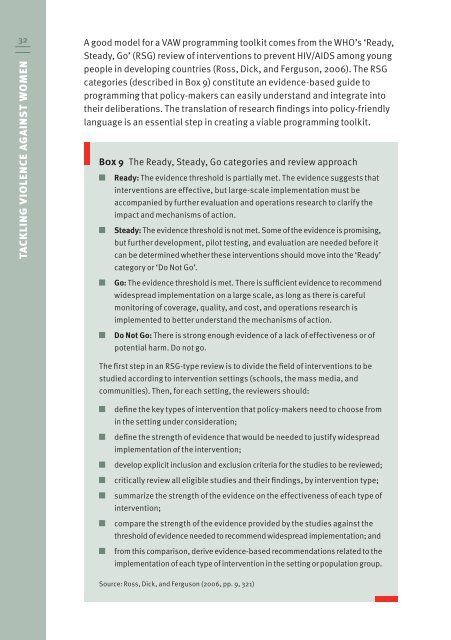Tackling Violence against Women: From Knowledge to Practical
Tackling Violence against Women: From Knowledge to Practical
Tackling Violence against Women: From Knowledge to Practical
You also want an ePaper? Increase the reach of your titles
YUMPU automatically turns print PDFs into web optimized ePapers that Google loves.
32<br />
TAckliNG ViolENcE AGAiNsT WomEN<br />
A good model for a VAw programming <strong>to</strong>olkit comes from the wHO’s ‘Ready,<br />
Steady, go’ (RSg) review of interventions <strong>to</strong> prevent HIV/AIDS among young<br />
people in developing countries (Ross, Dick, and Ferguson, 2006). The RSg<br />
categories (described in Box 9) constitute an evidence-based guide <strong>to</strong><br />
programming that policy-makers can easily understand and integrate in<strong>to</strong><br />
their deliberations. The translation of research findings in<strong>to</strong> policy-friendly<br />
language is an essential step in creating a viable programming <strong>to</strong>olkit.<br />
Box 9 The Ready, Steady, go categories and review approach<br />
ready: The evidence threshold is partially met. The evidence suggests that<br />
interventions are effective, but large-scale implementation must be<br />
accompanied by further evaluation and operations research <strong>to</strong> clarify the<br />
impact and mechanisms of action.<br />
steady: The evidence threshold is not met. Some of the evidence is promising,<br />
but further development, pilot testing, and evaluation are needed before it<br />
can be determined whether these interventions should move in<strong>to</strong> the ‘Ready’<br />
category or ‘Do Not go’.<br />
Go: The evidence threshold is met. There is sufficient evidence <strong>to</strong> recommend<br />
widespread implementation on a large scale, as long as there is careful<br />
moni<strong>to</strong>ring of coverage, quality, and cost, and operations research is<br />
implemented <strong>to</strong> better understand the mechanisms of action.<br />
do not Go: There is strong enough evidence of a lack of effectiveness or of<br />
potential harm. Do not go.<br />
The first step in an RSg-type review is <strong>to</strong> divide the field of interventions <strong>to</strong> be<br />
studied according <strong>to</strong> intervention settings (schools, the mass media, and<br />
communities). Then, for each setting, the reviewers should:<br />
define the key types of intervention that policy-makers need <strong>to</strong> choose from<br />
in the setting under consideration;<br />
define the strength of evidence that would be needed <strong>to</strong> justify widespread<br />
implementation of the intervention;<br />
develop explicit inclusion and exclusion criteria for the studies <strong>to</strong> be reviewed;<br />
critically review all eligible studies and their findings, by intervention type;<br />
summarize the strength of the evidence on the effectiveness of each type of<br />
intervention;<br />
compare the strength of the evidence provided by the studies <strong>against</strong> the<br />
threshold of evidence needed <strong>to</strong> recommend widespread implementation; and<br />
from this comparison, derive evidence-based recommendations related <strong>to</strong> the<br />
implementation of each type of intervention in the setting or population group.<br />
Source: Ross, Dick, and Ferguson (2006, pp. 9, 321)









